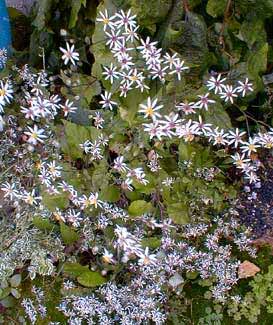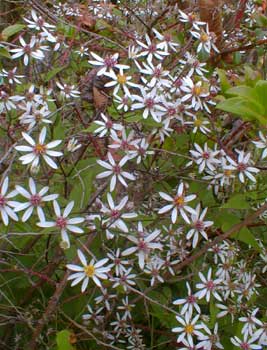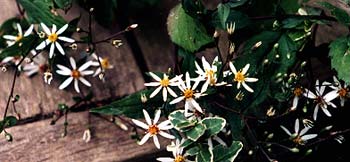
White
Wood-Aster
"The scarlet of the maples can shake me like a cry
Of bugles going by.
And my lonely spirit thrills
To see the frosty asters like a smoke upon the hills."
-Bliss Carman
(1861-1929)
(1861-1929)
 Perennial Wood Aster (Eurybia divaricata formerly Aster divaricatus) blooms late summer & early autumn (August & September), to the delight of butterflies. It produces numerous white stars sharply contrasting to its wiry black stems. The eye of each star is pinkish aging to yellow.
Perennial Wood Aster (Eurybia divaricata formerly Aster divaricatus) blooms late summer & early autumn (August & September), to the delight of butterflies. It produces numerous white stars sharply contrasting to its wiry black stems. The eye of each star is pinkish aging to yellow.The heart-shaped basal foliage is very pleasing, lending White Wood Asters the additional common name Heartleaf Asters. Leaves further out on stems are toothier. The darkness of the leaves further offsets the white snowflake-stars dramatically, followed by little fluffy seedheads which are themselves quite attractive.
A few years back we were given two starts from a friend's garden in which the wood asters had naturalized, & they have since then naturalized in our garden as well, though by no means to an invasive extent. They like the soil to be very well-draining or frequently dry, but not too droughty.
Sometimes called Serpentine Aster, it is normally quite floppy & zigzagging over the ground. There's a temptation to trim them to try to encourage them to behave in a clumpier more upright manner, but they bloom most heavily on the older floppiest parts of the plant rather than on the newer growth sprouting from the clumps. Staking them or getting to to be propped up by surrounding perennials seems a lost cause. So I've gotten used to them as spreading semi-creepers.
It will naturalize easily in either sun or bright shade. Over time their half-creeping mounds spread two feet high or so, & would be much taller if you held the creeping stems upright. They spread by rhizomes to colonize the immediate area, & nearby young plants transplant easily.
 This North American wildflower is native to the Appalachean Mountains & elsewhere from southern Ontario to Alabama. On the Atlantic side of the continent it may surprise gardeners that these are intentionally planted, as they are among the commonest wildflower, too pleasant to weed out of a garden, but freely had as volunteers (though it may well be endangered furthest north in its range). For those of us in the west they seem more novel. But White Wood Aster is more often used in Europe to brighten up shady gardens, & deserves overall more attention in its native land.
This North American wildflower is native to the Appalachean Mountains & elsewhere from southern Ontario to Alabama. On the Atlantic side of the continent it may surprise gardeners that these are intentionally planted, as they are among the commonest wildflower, too pleasant to weed out of a garden, but freely had as volunteers (though it may well be endangered furthest north in its range). For those of us in the west they seem more novel. But White Wood Aster is more often used in Europe to brighten up shady gardens, & deserves overall more attention in its native land.Here in the Northwest it seems to prefer a location to the sunnier side, & won't bloom quite so densely if in too much shade. In both areas where we have it planted, it creeps out from shadowed locations under shrubs to find the sunlight.
It has all the beauty of the more commonly seen Hardy Aster cultivars, but it adds subtlety & shade tolerance unlike the gaudier Hardy Asters. You can get another look at this same Wood Aster in a photo on the 'Emerald Gaeity' Wintercreeper page.